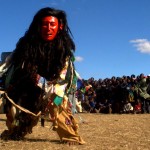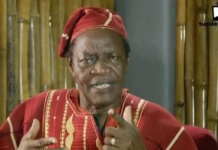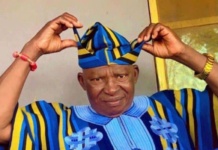
“GuleWamkulu”, literally meaning “big dance”, have become a sort of title for secret societies of traditional Chewa religious practices. The GuleWamkulu ceremonies consist of formally organized dances to admire the remarkable physical abilities of these individuals — considered to be adept at their dance as a result of their spiritual state. Informally, GuleWamkulu, or “Gule” is a term associated with anyone who participates in the rituals of these secret societies. The peak season for Gule occurs in July, with young men dressed as ancestral animals, trees, or in masks of ancestral spirits. The Gule themselves are initiated through formal ceremony into this society. Gule are considered to be in ‘animal state’ when they are dressed in such attire, and are not to be approached. If one has the misfortune of passing a Gule on the road, traditional behavior consists of dropping a few coins for the Gule — never handing them the money directly for fear they will grab you and take you to the cemetery for ritual purposes. Generally, it is best to avoid Gule in informal situations. In their animal or ancestral state, they are unpredictable.
Within the village, Gule may appear in small groups of 4 or 5 and villagers do their best to avoid any encounters. Gule are common in the afternoons, a strong incentive for tending to all business outside the home in the early hours. These secret societies have allowed for a close knit kinship between members of the Chewa — and equally divided them from neighbor groups.
Formally, the Gule-Wamkulu dance is performed when the headman requests such festivities, generally corresponding with weddings, funerals, or initiation rite ceremonies. The dances are a great source of celebration, and although the mystery and excitement still surrounds the presence of the GuleWamkulu, the community reacts to their show with great giddiness and giggles. There are a number of traditional dances of the GuleWamkulu, all performed for various events. The “Zilombo”, or masked dancers, perform with extraordinary movements and energy, wearing elaborate traditional masks and attire. According to local folklore, It is said that the Queen of England witnessed a traditional GuleWamkulu celebration, and was so captivated she asked to take some home; a request that was unfulfilled.
Masks worn by the GuleWamkulu include thousands of different representations — generally each developed hundreds of years ago by unique tribes, and accented with their own individual touch – for example one accenting bright colors, one dark. Today, these masks, with their different origins, are part of what is now the Chewa culture.
The female version of GuleWamkulu, called Chisamba, occurs for female initiation rituals. During this ceremony a woman is taken into a private room, and instructed by her elders of how to be a proper woman. The solidarity of these women does not diminish after the ceremony, but rather is rooted during this event. The celebratory Chisamba dance accompanies this event. Historically, a number of initiation practices have been involved — today these words of wisdom and celebratory event comprise the event.
Within a Chewa village the chiefs are a central unit of rule. Village life is somewhat self-contained, although not independent. Typical homes have numerous commodities that are purchased or obtained through bartering. Lamps, chairs, oil, salt, mats for sitting, pots and pans, and jewelry are commonly seen within the homes of some villagers. Chewa communities cover a vast land area and individual communities have progressed at their own pace. Those near the main road, for example, have increasingly adjusted to outside influence while those closer to the lake have developed a dependency and connection to utilization of this body of water.
Chewa rural life revolves around agricultural activities geared towards increasing production of maize (corn), vegetables, and groundnuts. All of these crops are used for consumption, and any excess is sold either within the village or occasionally at the increasing markets scattered along the roadside. The only crop produced predominately for sale in Chewa villages in central Malawi is tobacco. Tobacco is started slightly before maize, however the two crops are produced during the same season. This time of year, during land preparation, planting and maintaining crops, and of course the tremendously important harvest, provide focal points for the year.
Land ownership is determined by the village headman, and is constantly changing. With births, marriages, and deaths come changes in one’s land allotment. Sometimes a husband and wife will have their own land, while sometimes they will share, in which case the husband decides if and how to sell the excess. Traditionally, the Chewawere described as a matrilineal society, however the Chewa today include influences of both matrilineal and patrilineal leadership. Landowners are considered to be of higher status, however owning more land means working more land, and this often requires hiring additional labor. This informal employment consists of hiring neighbors to work as “Ganyu” or informal laborers. Women and men are hired as Ganyu labor, and payment is usually made in maize itself, and is often given upon completion of a particular project. Ganyu labor is essential to the functioning of the village, and creates a strong interdependency on one another.
Children are also a valuable source of labor, with young boys beginning to assist in farm activities. Young girls are also valuable to the functioning of these activities, as they are responsible for the laborious chores of fetching water, caring for younger children, helping their mothers cook, clean, take maize to the mill, and look after the sick. In addition, women and children laboriously process the staple crop of maize into the commonly eaten “Nsima”. Nsima requires much preparation; first the maize is dried, sorted, pounded, and finally cooked into a pasty patty. Routinely prepared with whatever vegetables are available, Nsima is eaten with the hands and used as a palate with which to scoop up the rest of the meal.
Since planting generally occurs around November, with the harvest seen near June, the days in between are filled with laborious work for adults and children. From June to October, however, the days are sometimes long and filled with much more free time. All households are required to spend a certain amount of time participating in activities that enhance village life — sometimes construction of the church, work on an elderly person’s land, or simply assisting as instructed by the village headman. In today’s modern day Chewa villages, the option exists to replace the community service hours with a simple payment to the village headman, intended as a contribution towards the community project. Aside from community service, some village women will engage in additional income generating activities, such as the sale of small goods (usually from the house garden), or occasionally crafted or handmade goods.
Formal village events generally include typical celebratory and mourning activities — birthdays, weddings, ritual transitions into adulthood, and the ever increasing funerals. All celebrations are elaborate, and it is at these events that the spirit of traditional Chewa culture comes to life — that is, the spirits of Chewa ancestors, and revered animals — come to life.
Just before planting season, the Gule Wamkulu presence is most abundant and the festivities are ablaze. In this village, not even the teacher, pictured below, could confront these students, her own students, about their absence from school that very day. Presently, schools do not formally consider the schedule of the GuleWamkulu in curriculum design.
Chewa children are responsible for a number of important household responsibilities. They are also responsible for a number of cultural activities — and wouldn’t consider rejecting these responsibilities








